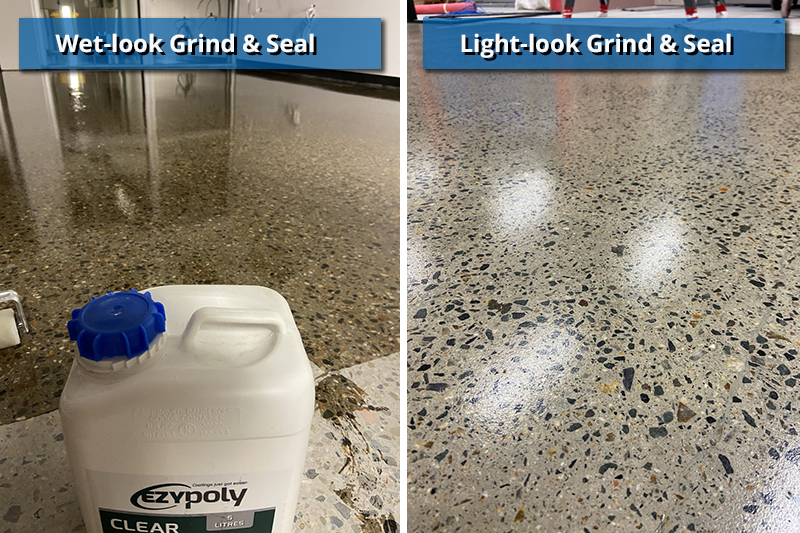Home › Do all grind and seal floors look the same?
In the resin flooring industry, the “grind and seal” floor is a popular choice for homes and businesses wanting a cost-effective flooring solution that looks modern and can offer some protection to the concrete underneath.
Unlike the polished concrete look that aims to mimic the high-end appearance of honed concrete finishes, these floors tend to have a patchy “salt and pepper” appearance from a standard grinding approach, and the resins applied can provide either a gloss or semi-gloss finish depending on the project requirements.
While they’re considered rather basic and perhaps even “low-end” floors to do, they’re not quite your typical one-size-fits-all job. In fact, there can be quite a variation in the way these floors behave, with the differences linked mainly to the type of clear sealers used.
When it comes to the grind and seal floors, we find there are two common types.
The first type of grind and seal is what I call the wet look. It has a much darker appearance, and the colours in the concrete tend to “pop” in the same way they do when you pour water over it.
The wet look is the type of grind and seal finish you achieve when solventless resins are used as the clear epoxy sealer. The reason they darken in such a fashion is because there are no solvents to flash off, so the resins tend to have more time to seep in and wet out the concrete to create a much richer colour.
As this type of grind and seal involves the penetration of solventless resins into the slab, they are typically more durable and the darker, more forgiving appearance lends itself to tougher service conditions.
The second type of grind and seal is the light-look version, which as the name suggests, tends to offer a much lighter and brighter finish than the wet look.
As you’d probably expect, the lighter look is achieved by doing the opposite of the wet look and applying resins that don’t wet out the concrete as thoroughly. This is typically done using thin films of clear water-borne or solvent-borne resins that tend to sit on the surface like a layer of cling wrap rather than soak into the slab.
While the lighter look tends to be more popular in residential and retail settings, this type of grind and seal can suffer more with issues such as impact and hot tyre pick-up.
As always, the choice of which type to use will come down to what’s most suited to the project demands. If the floor is going to be subject to heavy traffic and/or possible sources of impact, then the wet look is probably going to be the best option in most cases.
To help explain further, we had a recent enquiry from a clothing store in Mt. Isa wanting a light-look grind and seal. While it may have been a better match from a design point of view, there was a big risk such a floor would create problems when put back into service. The fact they regularly dragged around racks of clothing would severely test the water-based epoxies for adhesion and wear, and the red dirt tracked in by customers could become engrained and give the floor the permanently dirty look that retail businesses loathe.
In our experience, there are many clients like the one above that want a lighter look but can’t afford to give up the superior performance of solventless resins either. In those cases, we try to offer the best of both worlds by installing a clear water-based epoxy first, and then a matted coat of our solventless one-pack polyurethane, Ezypoly, over the top. For those that are happy with the wet look, we do a coat of clear solventless resin and finish off once again with a matted topcoat of Ezypoly.
We like the Ezypoly as the final coat for both the wet and light looks because the combination of abrasion-resistant polyurethane and matte finish provides the most forgiveness when it comes to general wear and tear. It must be noted, however, that even with the added durability of our approach, grind and seal systems are still not the best choice for harsh and testing environments.

Real World Epoxies has formulated, manufactured and supplied high-quality concrete sealers for more than two decades. We stand behind our products because we only use proven, high-quality materials that we know will perform as expected. If you’re a floor owner, builder or specifier with a grind and seal project, we can connect you with one of our recommended epoxy installers to provide a quote.
Let us help you with your concrete sealing needs when you fill out one of our contact forms or call us on 1300 EPOXIES (1300 376 943).
To help build a strong resin flooring industry that sits alongside timber, carpet, tiles and vinyl as a mainstream flooring option.
To eliminate preventable failures
that hurt the resin flooring industry
and prevent it from reaching its full potential.

